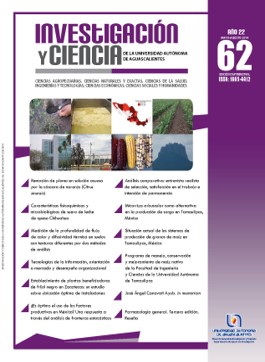Management, conservation, and improvement of the native maize program at the Engineering and Science Faculty in the State University of Tamaulipas
DOI:
https://doi.org/10.33064/iycuaa2014623641Keywords:
maize native, plant genetic resource, Tamaulipas, conservation, use plant breedingAbstract
The state of Tamaulipas is located inside the origin maize region with domestication and diversification properties. This genetic plant resource is in risk because genetic erosion has been increasing during the last years. In 2001, research scientists from the
Engineering and Science Faculty of the State University of Tamaulipas started a management, conservation, and improvement germplasm maize program. This program is a collaborative work between scientists from the School of Postgraduates and CIRNE-INIFAP where different research projects have developed. Most relevant results are: preservation of 215 native maize samples, germplasm with extended phenological variability covering a range from 50 to 90 days of flowering time, from 100 to 150 days of
physiological maturity stage, with drought and high temperature adaptation, and high yield of grain and forage.
Downloads
References
• ABOITES MANRIQUE, G. Una mirada diferente de la revolución verde. Ciencia, nación y compromiso social. México: Plaza y Valdés S.A. y C.V. 322 pp., 2002.
• AGUIRRE GÓMEZ, J. A. et al. Regional Analysis of Maize Biological Diversity in Southeastern Guanajuato, Mexico. Economic Botany, 54(1): 60-72, 2000.
• ÁNGELES ARRIETA, H. H. Mejoramiento genético del maíz en México: el INIA, sus antecesores y un vistazo a sus sucesor, el
INIFAP. Agricultura Técnica en México, 26(1): 31-48, 2000.
• BENÍTEZ DE NORIEGA, A. Historia de la Hacienda del Carmen de Benítez, México. México: Miguel Ángel Porrúa, 77 pp., 1989.
• BIRD, R. M. A name change for central american teosinte. Taxon, 27(4): 361-363, 1978.
• CASTRO NAVA, S. et al. Exploración de germoplasma nativo de maíz en el centro y sur de Tamaulipas, México. Revista Mexicana de Ciencias Agrícolas, 4 (4):645-653, 2013.
• GARZA-CASTILLO, M. R. La conservación de recursos genéticos del maíz nativo en Tamaulipas. Revista Ciencia UAT, 16 (2):22-27, 2010.
• HERNÁNDEZ CASILLAS, J. M. y ESQUIVEL ESQUIVEL, G. Rendimiento de grano y características agronómicas en germoplasma de maíz de Valles Altos de México. Revista Fitotecnia Mexicana, 27 (1):27-31, 2004.
• LÓPEZ LOZANO, M. El cultivo de maíz en México y la contribución del fitomejorador para favorecer la autosuficiencia. Revista Mexicana de Agronegocios, 7 (12):596-605, 2003.
• MASSIEU TRIGO, Y. y LECHUGA MONTENEGRO, J. El maíz en México: biodiversidad y cambios en el consumo. Análisis Económico, XVII (36):281-303, 2002.
• MIRANDA COLIN, S. Evolución de cuatro caracteres del maíz (Zea mays L.). Agrociencia, 28:73-88, 1977.
• NÁJERA CALVO, L. A. et al. Potencial de rendimiento de poblaciones criollas de maíz de Coahuila, México. Revista Fitotecnia Mexicana, 33(número especial 4): 31-36, 2010.
• PECINA MARTÍNEZ, J. A. et al. Rendimiento de grano y sus componentes en maíces nativos de Tamaulipas evaluados en ambientes contrastantes. Revista Fitotecnia Mexicana, 34(2):85-92, 2011.
• PIPERNO, D. R. et al. Starch grain and phytolith evidence for early ninth millennium B.P. maize from the Central Balsas River Valley, Mexico. Proceedings of the National Academy of Sciences of the United States of America, 106(13): 5019-5024, 2009.
• POLANCO JAIME, A. y FLORES MÉNDEZ, T. Bases para una política de i&d e innovación de la cadena de valor del maíz. México: Foro Consultivo Científico y Tecnológico, A. C., 246 pp., 2008.
• RANERE, A. J. et al. The cultural and chronological context of early Holocene maize and squash domestication in the Central Balsas River Valley, Mexico. Proceedings of the National Academy of Sciences of the United States of America, 106(13): 5014-5018, 2009.
• REYES CASTAÑEDA, P. Cincuenta años de investigación agrícola de maíz para tierra caliente en México. Agricultura Técnica en México, 26(1): 49-62, 2000.
• REYES, J. R. Formación y comparación de rendimiento de 135 cruzas dobles en tres poblaciones de maíz (Zea mays L.). Tesis de Licenciatura. Universidad Autónoma de Tamaulipas. México. 80 pp., 1985.
• REYES MÉNDEZ, C. A. y CANTÚ ALMAGUER, M. A. H-437, Híbrido de maíz para el noreste de México. Revista Fitotecnia Mexicana, 27(3): 289-290, 2004.
• REYES MÉNDEZ, C. A. y CANTÚ ALMAGUER, M. A. H-439, Nuevo híbrido trilineal de maíz para áreas de riego en el subtrópico de México. Agricultura Técnica en México, 31(1): 97-100, 2005.
• REYES MÉNDEZ, C. A. y CANTÚ ALMAGUER, M. A. H-443-A, Híbrido de maíz de grano amarillo para el noreste de México. Revista Fitotecnia Mexicana, 32(4): 331-333, 2009.
• REYES MÉNDEZ, C. A. y CANTÚ ALMAGUER, M. A. Maíz. En: RODRÍGUEZ DEL BOSQUE, L. A. (Coord.), Campo experimental Río Bravo: 50 años de investigación agropecuaria en el norte de Tamaulipas, historia, logros y retos, pp. 55-74, INIFAP, 325 pp., 2006.
• REYES MÉNDEZ, C. A. et al. H-440, Nuevo híbrido de maíz tolerante a sequía para el noreste de México. Agricultura Técnica en México, 33(2): 201-204, 2007.
• SÁNCHEZ, J. J. et al. Isozimatic and morphological diversity in the races of maize of México. Economic Botany, 54(1): 43-59, 2000.
• SMITH, B. D. Documenting plant domestication: The consilience of biological and archaeological approaches. Proceeding of National Academy of Sciences of the United States of America, 98(4): 1324-1326, 2001.
• SMITH, B. D. Reconsidering the Ocampo caves and the era of incipient cultivation in Mesoamerica. Latin American Antiquity, 8(4): 342-383, 1997.
De páginas electrónicas
• CONABIO. 2011. Base de datos del proyecto global “Recopilación, generación, actualización y análisis de información acerca de la diversidad genética de maíces y sus parientes silvestres en México”. Octubre de 2010. CONABIO. México, D. F. http://www.biodiversidad.gob.mx/
genes/proyectoMaices.html
Downloads
Published
How to Cite
License
Copyright (c) 2014 Javier González Martínez, José Alberto López Santillán, Florencio Briones Encinia, Sóstenes Edmundo Varela Fuentes, César Augusto Reyes Méndez, José Agapito Pecina Martínez

This work is licensed under a Creative Commons Attribution-NonCommercial-ShareAlike 4.0 International License.
Las obras publicadas en versión electrónica de la revista están bajo la licencia Creative Commons Atribución-NoComercial-CompartirIgual 4.0 Internacional (CC BY-NC-SA 4.0)









